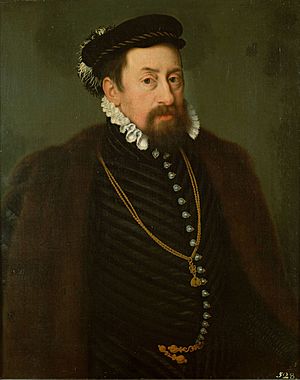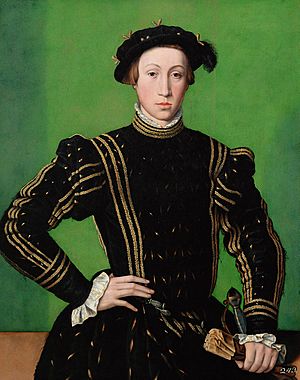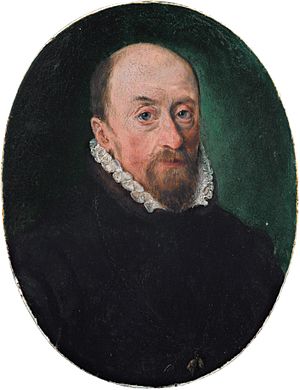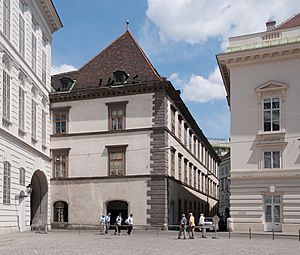Maximilian II, Holy Roman Emperor facts for kids
Quick facts for kids Maximilian II |
|
|---|---|

Portrait by Nicolas Neufchâtel, c. 1566
|
|
| Holy Roman Emperor Archduke of Austria |
|
| Reign | 25 July 1564 – 12 October 1576 |
| Predecessor | Ferdinand I |
| Successor | Rudolf II |
| King of Bohemia | |
| Reign | 20 September 1562 – 12 October 1576 |
| Coronation | 20 September 1562, Prague |
| Predecessor | Ferdinand I |
| Successor | Rudolf II |
| King of the Romans (King of Germany) |
|
| Reign | 28 November 1562 – 12 October 1576 |
| Coronation | 30 November 1562, Frankfurt |
| Predecessor | Ferdinand I |
| Successor | Rudolf II |
| King of Hungary and Croatia contested by John II Sigismund (1564–70) |
|
| Reign | 8 September 1563 – 12 October 1576 |
| Coronation | 8 September 1563, Pressburg |
| Predecessor | Ferdinand I |
| Successor | Rudolf II |
| Born | 31 July 1527 Vienna, Archduchy of Austria |
| Died | 12 October 1576 (aged 49) Imperial City of Regensburg |
| Burial | Prague, St. Vitus Cathedral |
| Spouse | |
| Issue |
|
| House | Habsburg |
| Father | Ferdinand I |
| Mother | Anna of Bohemia and Hungary |
| Religion | Roman Catholicism |
| Signature | |
Maximilian II (born July 31, 1527 – died October 12, 1576) was a very important ruler in Europe. He belonged to the House of Habsburg, a powerful family. From 1564 until his death, he was the Holy Roman Emperor.
Before becoming Emperor, he was crowned King of Bohemia in Prague in 1562. He was also chosen as King of Germany and King of Hungary and Croatia. When his father, Ferdinand I, passed away in 1564, Maximilian became the ruler of the large Holy Roman Empire.
Maximilian's time as ruler was shaped by big changes in religion after the 1555 Peace of Augsburg. Even though he was a Catholic, he tried to work with Lutheran leaders. He hoped to bring different Christian groups together, but this plan did not fully succeed. He also had to deal with ongoing wars against the Ottomans and disagreements with his cousins in Habsburg Spain.
Historians say Maximilian wanted to make the government better, unite Christians, and push the Ottomans out of Hungary. He worked hard on these goals throughout his reign.
Contents
Biography of Maximilian II
Early Life and Education
Maximilian was born in Vienna, Austria, on July 31, 1527. He was the oldest son of Ferdinand I and Anna of Bohemia and Hungary. His great-grandfather, Maximilian I, was also an Emperor, and Maximilian was named after him.
When Maximilian was born, his father Ferdinand became King of Bohemia and Hungary. This helped create the large Habsburg Monarchy. Maximilian spent his childhood in Innsbruck, Tyrol. He studied mainly in Italy with smart teachers called humanists.
He learned about Lutheranism and even wrote letters to Protestant leaders. This made his Catholic relatives a bit worried. When he was 17, he gained experience in war. He fought alongside his uncle, Emperor Charles V, in a war against France in 1544. He also fought in the Schmalkaldic War. After a big victory in 1547, Maximilian started to get involved in important Imperial matters.
Becoming the Next Ruler
On September 13, 1548, Emperor Charles V arranged for Maximilian to marry his own daughter, Maria of Spain. Maria was Maximilian's cousin. This marriage was meant to make the Spanish and Austrian branches of the Habsburg family stronger. It also aimed to strengthen Maximilian's Catholic faith.
Maximilian spent some time in Spain, representing the Emperor. However, he wanted to be in charge of the Habsburg Netherlands, but that didn't happen. His father, King Ferdinand, put Maximilian's younger brother, Ferdinand II, in charge of Bohemia. Still, Maximilian's right to become the next king was officially recognized in 1549.

Maximilian returned to Germany in 1550 to discuss who would be the next Emperor. His relationship with his uncle Charles V became difficult. Charles V wanted his own son, Philip II of Spain, to become Emperor after him. But Maximilian and his father Ferdinand disagreed.
Maximilian even sought support from German princes, including some Protestant leaders. Eventually, they reached a compromise. Philip would succeed Ferdinand, but Maximilian would govern Germany as King of the Romans. This plan didn't fully happen, but it showed the growing tension between the two Habsburg family branches. Some even thought Maximilian was poisoned in 1552 because of this rivalry.
Maximilian and Philip were very different. Philip grew up in Spain and rarely left it. Maximilian saw himself as a German prince and often disliked Spaniards. Philip was quiet, while Maximilian was outgoing and friendly. Maximilian believed in humanism and religious tolerance. Philip was very dedicated to the Catholic faith. Despite their differences, they both wanted their family dynasty to stay united.
Life in Vienna and Religious Views
In 1551, Maximilian attended the Council of Trent. The next year, he moved into the Hofburg Palace in Vienna. He was welcomed with a grand parade, which even included an elephant named Suleiman.
While his father Ferdinand made peace with Protestant leaders in 1552 and 1555, Maximilian focused on governing Austria. He also defended Austria against attacks from the Ottomans. In Vienna, he expanded his palace with the Stallburg wing. This area later became the famous Spanish Riding School. He also ordered the building of Neugebäude Palace.
Maximilian's court had strong ties to the University of Vienna. Scholars like the botanist Carolus Clusius worked for him. His library later became the start of the Austrian National Library. Vienna was a large city in Central Europe during the 1550s, with over 50,000 people.
Maximilian's religious beliefs were not always clear. He had learned about Lutheranism when he was young. His friendly relationships with Protestant princes were likely for political reasons. However, in Vienna, he became close with a preacher who leaned towards Lutheranism. This worried his father.
People feared he might leave the Catholic Church. In 1558, his father Ferdinand even told the Pope that Maximilian would not become Emperor if he left the Church. In the end, Maximilian remained Catholic, but his views were still influenced by Lutheranism. In 1560, he agreed to send the preacher away and started attending Catholic Masses again.
Maximilian's Reign as Emperor
Becoming Emperor and Early Challenges
In November 1562, Maximilian was chosen as King of the Romans (German king) in Frankfurt. He was crowned a few days later. He promised Catholic leaders he would stay true to their faith. He also promised Protestant leaders he would accept their beliefs when he became Emperor. He was the first King of the Romans not to be crowned in Aachen.
In September 1563, he was crowned King of Hungary. When his father died in July 1564, Maximilian became the Holy Roman Emperor. He also inherited the kingdoms of Hungary, Croatia, and Bohemia.
Maximilian believed the Church needed big changes. However, he could not get the Pope to agree to priests being allowed to marry. In 1568, a special religious practice for ordinary people was stopped. Maximilian, though, allowed Lutheran nobles in Austria to practice their religion freely. He also refused to publish certain Church rules.
Wars and Treaties
In March 1566, Maximilian met with the Diet of Augsburg. Protestants had high hopes, but he did not agree to their demands. While religious differences were discussed, no strong actions were taken to stop them. The main outcome was an agreement to help with the war against the Turks, which had just started again.
Maximilian gathered a large army to fight the Ottomans. However, neither side won a major victory. The Ottomans captured Szigetvár in 1566, but their leader, Suleiman the Magnificent, died during the siege. Since neither side had a clear win, Maximilian's representatives met with the Ottoman Grand Vizier to negotiate a truce.

In 1568, they signed the Treaty of Adrianople. This treaty meant that the Emperor had to accept Ottoman control over certain regions like Transylvania.
Later Reign and Family Life
Over time, Maximilian's relationship with his cousin Philip of Spain got better. Philip's son, Don Carlos, died, which meant Maximilian or one of his sons could potentially inherit the Spanish throne. This made Maximilian more careful in religious matters.
In 1570, Maximilian's daughter, Anna, married Philip II. This showed the improved friendship between them. However, Maximilian could not stop Philip's harsh actions against people rebelling in the Netherlands.
In 1570, Maximilian asked for help to defend his eastern borders. He also wanted power to control foreign soldiers passing through Germany. He suggested that his permission should be needed before any soldiers were hired for foreign service. But the German states did not want to give the Emperor more power. Protestant princes worried it would stop them from helping their fellow Protestants in France and the Netherlands. So, nothing was done, though some help was given for Austria's defense.
In 1575, some Polish and Lithuanian nobles chose Maximilian to be their king. However, he was not widely accepted and had to leave Poland.
Maximilian died on October 12, 1576, in Regensburg. He was preparing to invade Poland at the time. He is buried in St. Vitus Cathedral in Prague.
Maximilian and his wife Maria had sixteen children, ten sons and six daughters. His oldest surviving son, Rudolf, became the next Emperor. Another son, Matthias, also became Emperor later. Several other sons played roles in governing Habsburg lands. His daughter, Elizabeth, married Charles IX of France.
Religious Policies and Legacy
Maximilian's policies of religious neutrality helped bring peace to the Holy Roman Empire. Both Catholics and Protestants got a break after the early struggles of the Reformation. During his reign, Protestantism grew strong in Austria and Bohemia. Unlike the rulers who came after him, Maximilian did not try to stop it.
He did disappoint some German Protestant princes by not giving them control over certain church lands. However, he personally allowed Protestant nobles to worship freely. He also worked to reform the Catholic Church, including trying to allow priests to marry. This failed because Spain opposed it.
Maximilian II was a member of the Order of the Golden Fleece, a famous knightly order.
Marriage and Children

On September 13, 1548, Maximilian married his first cousin, Maria of Spain. She was the daughter of Emperor Charles V. Maria was very devoted to Spain and the Catholic Church. Despite their differences, their marriage was a happy one. They had sixteen children:
- Archduchess Anna of Austria (1549–1580). She married Philip II of Spain and was the mother of Philip III of Spain.
- Archduke Ferdinand of Austria (1551–1552).
- Rudolf II, Holy Roman Emperor (1552–1612).
- Archduke Ernest of Austria (1553–1595). He served as Governor of the Low Countries.
- Archduchess Elisabeth of Austria (1554–1592). She married Charles IX of France.
- Archduchess Marie of Austria (1555–1556).
- Matthias, Holy Roman Emperor (1557–1619).
- A stillborn son (1557).
- Archduke Maximilian of Austria (1558–1618). He was chosen as King of Poland but never crowned.
- Archduke Albert of Austria (1559–1621). He also served as Governor of the Low Countries.
- Archduke Wenceslaus of Austria (1561–1578).
- Archduke Frederick of Austria (1562–1563).
- Archduchess Marie of Austria (1564). Named after her older sister who had passed away.
- Archduke Charles of Austria (1565–1566).
- Archduchess Margaret of Austria (1567–1633). She became a nun.
- Archduchess Eleanor of Austria (1568–1580).
See also
 In Spanish: Maximiliano II de Habsburgo para niños
In Spanish: Maximiliano II de Habsburgo para niños


